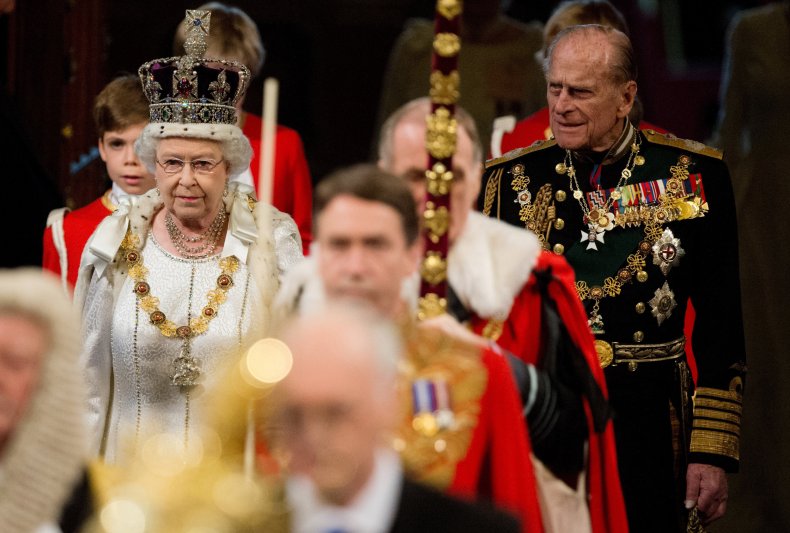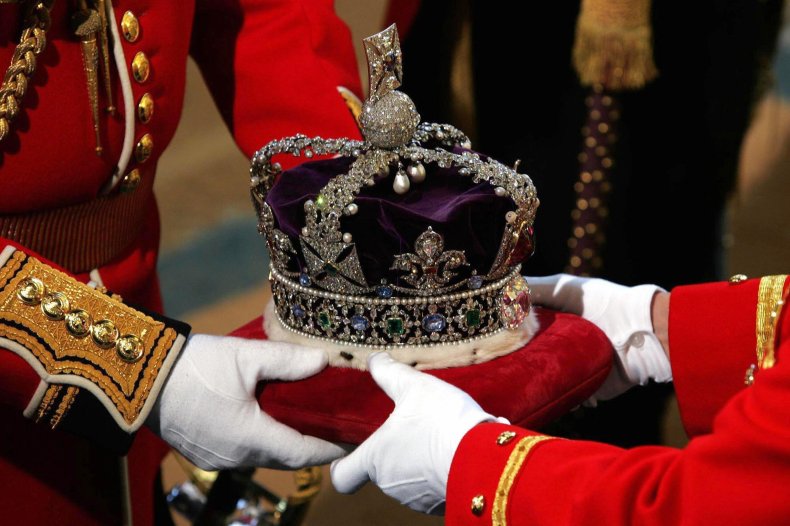- Joined
- Feb 26, 2019
- Messages
- 12,449
- Points
- 113
Calls Grow for Return of Crown Jewels to India, Africa After Queen's Death
newsweek.com
People in Africa and India have called for the return of some of the crown jewels after Queen Elizabeth II's death.
The queen died on Thursday at age 96, Buckingham Palace confirmed.
The crown jewels include a collection of some of the world's most rare and expensive gemstones.
 Queen Elizabeth II, wearing the Imperial State Crown, and Prince Philip proceed at the State Opening of Parliament on May 9, 2012, in London, England. People have called for some of the crown jewels to be returned to their country of origin. Leon Neal - WPA Pool/Getty Images Europe
Queen Elizabeth II, wearing the Imperial State Crown, and Prince Philip proceed at the State Opening of Parliament on May 9, 2012, in London, England. People have called for some of the crown jewels to be returned to their country of origin. Leon Neal - WPA Pool/Getty Images Europe
Two of the jewels people are calling for to be returned are the Koh-i-noor diamond from India and the Great Star of Africa, estimated to be worth about $400 million each.
Their acquisition is steeped in controversy given the history of British colonialism.
People have now called on the royal family to use the Queen's death as an opportunity to return the jewels.
"Can India get back the kohinoor diamond/everything in the British museum that was stolen?" wrote one person on Twitter.
Another said: "so when will those colonizers give us back that kohinoor diamond they took from us?!??"
A third wrote: "Britain should return "The Great Star of Africa" back to Africa in South Africa where it belongs or they will forever be thieves."
Probably the world's most famous diamond, the Koh-i-noor weighed 105.6 carats when it was found in southern India, possibly as early as the 1300s.
 The crown worn by Queen Elizabeth II arrives at the Sovereign Entrance of the House of Lords, in London, on November 6, 2007, for the State Opening of Parliament. The crown jewels feature some of the world's most expensive diamonds. Cathal McNaughton/AFP
The crown worn by Queen Elizabeth II arrives at the Sovereign Entrance of the House of Lords, in London, on November 6, 2007, for the State Opening of Parliament. The crown jewels feature some of the world's most expensive diamonds. Cathal McNaughton/AFP
It takes pride of place at the top of the crown made for the Queen Mother in 1937 and many people have claimed ownership of it over the centuries including Mughal emperors, shahs of Iran, emirs of Afghanistan, and Sikh maharajas.
Britain came in to possession of the Koh-i-noor when the East India Company took the jewel from deposed ten-year-old Maharaja Duleep Singh in 1849.
It was part of the Treaty of Lahore, which declared it must be surrendered to Queen Victoria.
The Cullinan diamond was discovered in what is now South Africa and was the largest uncut diamond ever found at 3,106 carats, which is a little more than one pound.
It was subsequently cut into nine major stones and 96 smaller brilliants, with the British monarchy owning a number of them.
The Great Star of Africa sits in the Queen's sceptre, while another stone, known as the Cullinan II or Second Star of Africa, is set in the front band of the Imperial State Crown.
The stones that make up the Cullinan diamond are valued in total at $2 billion.
The queen also owned the Cullinan's next two biggest stones which she had set in a brooch and became known as "Granny's Chips."
The Imperial State Crown, along with a sceptre, serves as the principal crown for the British monarch.
The current state crown was made in 1937 for the queen's father, King George VI, and is based on the crown made in 1837 for Queen Victoria. It contains a number of the British monarchy's most historic jewels—including St Edward's Sapphire, the oldest gemstone in the collection.
 The crown containing the famous Koh-i-noor diamond. People have called for the diamond be returned to India. Tim Graham/Getty Images
The crown containing the famous Koh-i-noor diamond. People have called for the diamond be returned to India. Tim Graham/Getty Images
This blue stone has been set into the center of the crown and is said to have belonged to Edward the Confessor, who ascended to the throne in 1042.
In total the the crown is set with 2,868 diamonds, 17 sapphires, 11 emeralds, 269 pearls, and four rubies.
The majority of the crown jewels are reserved for use in the coronation ceremony, but the Imperial State Crown was worn by the queen every year of her reign for the State Opening of Parliament until 2017.
In 2019, it was decided that the crown was too heavy for the monarch, who was then in her 90s, and she wore the George VI Diamond Diadem instead.
newsweek.com
People in Africa and India have called for the return of some of the crown jewels after Queen Elizabeth II's death.
The queen died on Thursday at age 96, Buckingham Palace confirmed.
The crown jewels include a collection of some of the world's most rare and expensive gemstones.

Two of the jewels people are calling for to be returned are the Koh-i-noor diamond from India and the Great Star of Africa, estimated to be worth about $400 million each.
Their acquisition is steeped in controversy given the history of British colonialism.
People have now called on the royal family to use the Queen's death as an opportunity to return the jewels.
"Can India get back the kohinoor diamond/everything in the British museum that was stolen?" wrote one person on Twitter.
Another said: "so when will those colonizers give us back that kohinoor diamond they took from us?!??"
A third wrote: "Britain should return "The Great Star of Africa" back to Africa in South Africa where it belongs or they will forever be thieves."
Probably the world's most famous diamond, the Koh-i-noor weighed 105.6 carats when it was found in southern India, possibly as early as the 1300s.

It takes pride of place at the top of the crown made for the Queen Mother in 1937 and many people have claimed ownership of it over the centuries including Mughal emperors, shahs of Iran, emirs of Afghanistan, and Sikh maharajas.
Britain came in to possession of the Koh-i-noor when the East India Company took the jewel from deposed ten-year-old Maharaja Duleep Singh in 1849.
It was part of the Treaty of Lahore, which declared it must be surrendered to Queen Victoria.
The Cullinan diamond was discovered in what is now South Africa and was the largest uncut diamond ever found at 3,106 carats, which is a little more than one pound.
It was subsequently cut into nine major stones and 96 smaller brilliants, with the British monarchy owning a number of them.
The Great Star of Africa sits in the Queen's sceptre, while another stone, known as the Cullinan II or Second Star of Africa, is set in the front band of the Imperial State Crown.
The stones that make up the Cullinan diamond are valued in total at $2 billion.
The queen also owned the Cullinan's next two biggest stones which she had set in a brooch and became known as "Granny's Chips."
The Imperial State Crown, along with a sceptre, serves as the principal crown for the British monarch.
The current state crown was made in 1937 for the queen's father, King George VI, and is based on the crown made in 1837 for Queen Victoria. It contains a number of the British monarchy's most historic jewels—including St Edward's Sapphire, the oldest gemstone in the collection.

This blue stone has been set into the center of the crown and is said to have belonged to Edward the Confessor, who ascended to the throne in 1042.
In total the the crown is set with 2,868 diamonds, 17 sapphires, 11 emeralds, 269 pearls, and four rubies.
The majority of the crown jewels are reserved for use in the coronation ceremony, but the Imperial State Crown was worn by the queen every year of her reign for the State Opening of Parliament until 2017.
In 2019, it was decided that the crown was too heavy for the monarch, who was then in her 90s, and she wore the George VI Diamond Diadem instead.







